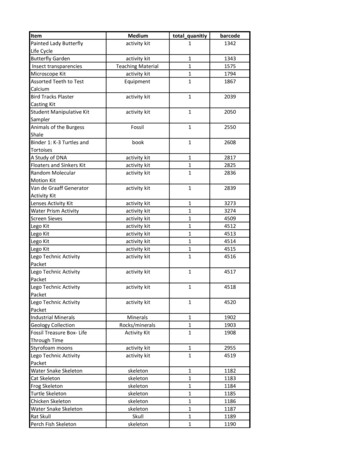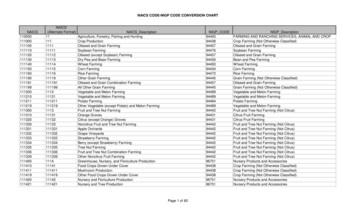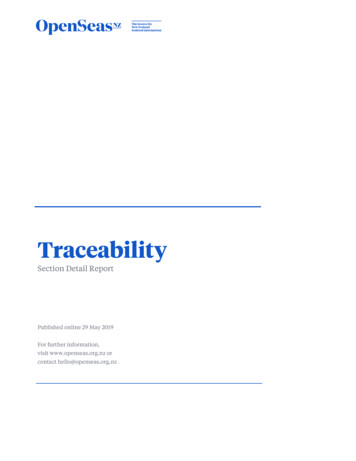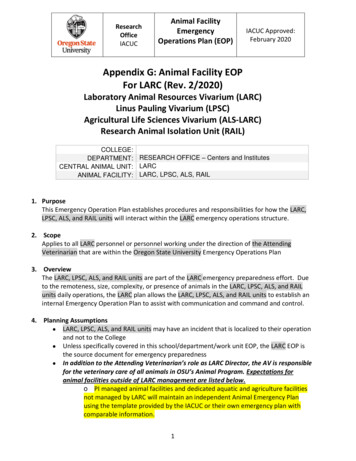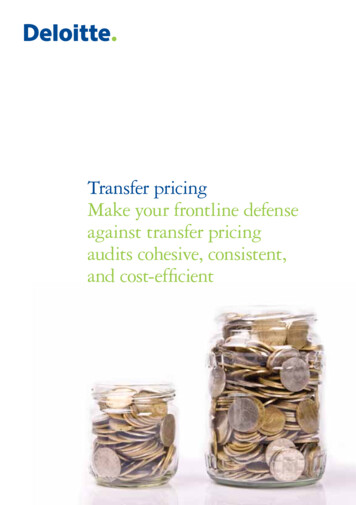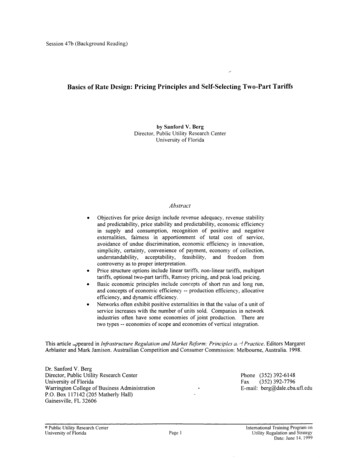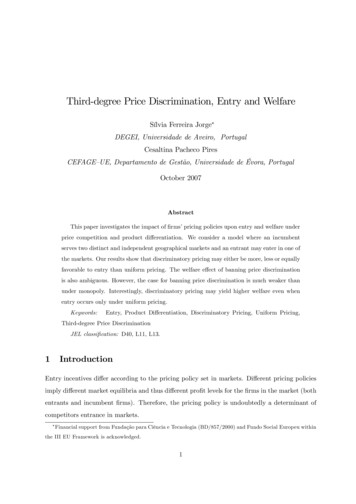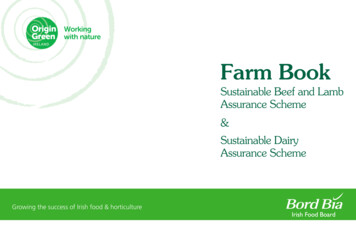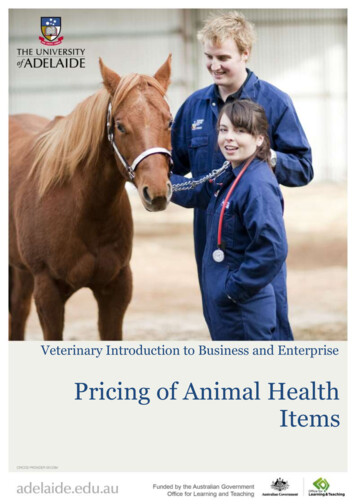
Transcription
Veterinary Introduction to Business and EnterprisePricing of Animal HealthItems
Vibe Learning GuidePricing of Animal Health Items - the Mark-Up Method.Table of ContentsOverview. 2Learning Outcomes . 3Understanding costs and pricing of animal health items. 3Introduction . 4The Mark-Up Method of Pricing . 5Difference between margin and mark-up . 6Optimal mark-up and sale price . 7Lower mark-ups for large quantities . 8Inventory management . 8Inventory levels . 9Inventory turnover . 10Inventory controls . 10Effect of wastage and missed charges on mark-up and margin . 11Problems for self-study . 13References and further reading. 13Authors . 13Acknowledgements . 13With the exception of the Commonwealth Coat of Arms, and where otherwise noted, all materialpresented in this document is provided under Creative Commons Attribution-ShareAlike 4.0 UnportedLicense rviewThe pricing and management of animal health items is covered in these topic notes. Thisincludes the mark-up method which is commonly used to arrive at the final price for animalhealth related items, and the basics of inventory management. Further information about thecharging and invoicing procedures is presented in the topic notes titled How to Charge.The University of Adelaide2
Learning OutcomesOn completion of this topic students should be able to: Describe the two components of a typical veterinary businessDiscuss the need for effective animal health product managementBe able to apply the mark-up method of inventory pricingKnow the difference between margin and mark-upUnderstanding costs and pricing of animal healthitemsVeterinarians need to understand inventory management and pricing. Although the corebusiness of veterinary practice is the sale of knowledge in the form of professional services,sales of animal health items are necessary for a majority of veterinary businesses. Bothemployed and owner veterinarians need to understand the rationale and aims of effectiveinventory management and pricing, so they can contribute to the strength and success of aveterinary business.Veterinary care involves professional services and usually includes the provision of laboratoryservices, prescription drugs and non-prescription materials. As supply of drugs and nonprescription items is an important contributor to veterinary business income, it is important tohave a working knowledge of accounting methodologies for arriving at pricing of veterinarysupplied items. Effective inventory pricing and management is an area that offers significantpositive impact in the areas of cost containment and profitability (Ackermann, 2007).Veterinarians are commonly asked, ‘Why are animal medications so expensive?’ In response tothis question, it is worth pointing out that there is no Pharmaceutical Benefits Scheme (PBS) forveterinary medications, so without government subsidy the full cost must be passed on to theclient. Nonetheless, some drugs are cheaper for animals than the equivalent or similar forhumans. Understanding how prices are derived will help you be confident in the value of thecost to the client, and also help you understand that a general attitude of conservation and nonwaste among staff of the practice is extremely important (Ackermann, 2007).These topic notes do not intend to teach deeply into accounting methodologies, rather theyprovide an introduction to the basic of methods of pricing externally sourced items, using themark up method of pricing. Once the basic method of mark-up pricing of veterinary items isunderstood, then informed adjustments to pricing of veterinary items can be made.The University of Adelaide3
IntroductionVeterinary businesses have two main components: sale of professional services sale of animal health itemsWhile the sale of veterinary knowledge in the form of professional services is the core businessfor a veterinary business, the supply of animal health items also contributes to veterinarybusiness income. Both parts of the veterinary business, professional services and animal healthitems, should contribute significantly to the profit margin of the business. In fact, practices thatrely on sales of animal health items for a higher proportion of profit are vulnerable to largersuppliers with increased purchasing capacity taking the market share.Recent examples of this include: dairy farms in New Zealand are now able to request a prescription from their veterinarian andhave the drugs supplied by a pharmacy, so veterinarians are not able to gain as much of incomefrom product sales. supermarkets, pet barns and on-line suppliers of pet food, flea control products and wormers aresignificant suppliers of these items to the animal owner; on-line suppliers of preventative animalhealth care items often deliver to your door.In veterinary practice, clinical services are provided to clients for acute and ongoing healthmanagement, and these services require the business to stock and supply prescription only andnon-prescription animal health items. In addition, veterinary clinical practices, and animalhealth consultancy practices, utilise pathology tests or the attendance of visiting specialists asrequired for monitoring or diagnosis of animal health status. For the purpose of simplicity,prescription and non-prescription medications, and external services, are all termed animalhealth items, and examples of these include: prescription only medicines and prescription pet foods pathology panels for in-house diagnostics pathology tests performed by external laboratories non-prescription goods e.g. general pet foods, wormers and dental care attending specialist visits e.g. ultrasonographer, behaviouralist, orthopaedic surgeonThe University of Adelaide4
Demand for these items can be variable. Variability in need for animal health items can berelated to: normal or abnormal seasonal variability, for example summer vs winter, drought years or floods economic variability, such as local employment levels in suburban areas, national or globaleconomic effects (recessions), or sector economics of production (e.g. high Australian dollardepressing beef export demand and value of stock)Due to variability in demand, animal health goods, visiting specialists or laboratory tests areknown as variable cost items as these are costs for which the veterinary business orders in on ajust in time or as needed basis.The Mark-Up Method of PricingA veterinary business orders, records, stores and labels, and communicates with the clientabout appropriate use of a product or the results of the test performed. Furthermore, theveterinary business is responsible to pay for ordered items. Thus, when an animal health itemis provided to a client, the client should pay for it, otherwise the veterinary business is losingmoney.On occasion, animal health items may be damaged or the use by date may expire before an itemis sold, these items are classified as wastage. To generate a margin, and cover the cost ofwastage and staff time involved in handling stock, items are charged to the client at a higherprice than the purchase price to the business. Thus, the item is marked-up before sale. Theformula for determining the sale price of a product is to multiply the cost by a factor to increaseproduct price to higher than cost. The mark-up factor is always a figure greater than 1.0, unlessthe product is designated as a loss-leader product and is priced below cost. For example, a 1item with a mark-up factor of 1.5 will have a selling price of 1.50. Mark-up is also commonlyreferred to as an amount or a percentage. To illustrate, a 1 item that sells for 1.50 is markedup the amount of 50c and has a 50% mark-up. See Table 1 below for illustration of differentmark-ups.The mark-up equation is represented as:cost x mark-up factor selling priceCalculation of mark-up percentage:mark-up % (mark-up amount/cost) x 100The University of Adelaide5
Difference between margin and mark-upMark-up and margin are related, but different, concepts in regard to determination of sellingprice. Selling price for an item is determined by multiplying cost by the mark-up factor,whereas margin is the difference between the selling price and the cost. Thus, selling price isdetermined either by multiplication by a mark-up factor, or by adding a required amount ofmargin to the cost. The equation for margin is:cost margin selling priceWhen considered as an amount mark-up and margin are the same, but when expressed as apercentage they have different values. As shown above, mark-up percentage is calculated as:mark-up % (mark-up amount/cost) x 100and, margin percentage is calculated as:margin % (margin amount/selling price) x 100For example, a 1.00 item that sells for 1.50 has a mark-up percentage of 50% and a marginpercentage of 33%.Table 1 below provides examples of mark-up and margins, illustrating how the mark-up factoris usually 1.0* x the cost price and the margin is always 1.0 and 100% of the selling price.* Note: for loss leaders, the mark-up factor can be 1.0. For a more detailed discussion ofmargins and loss leaders see the topic notes: Fee Setting.Table 1: Examples of mark-up and marginsCost ofproductMark-upfactorMark-up Mark-up %SellingpriceMarginequationMargin % 12.0 1100% 2 1/ 250% 11.5 0.5050% 1.50 0.50/ 1.5033% 11.25 0.2525% 1.25 0.25/ 1.2520%The University of Adelaide6
Optimal mark-up and sale priceThe optimal mark-up, and sale price, on an item is arrived at by balancing the following: the cost of holding the items prior to sale, as opposed to the monies being invested elsewherethe cost of storage – infrastructure and legal requirementstypical wastage/loss associated with unsold stock - non-prescription medical items (e.g.dressings, pins, plates) have a high wastage factor or holding cost so need a high mark up (e.g.300%).prices set by competing businesses, including non-veterinary businesses, such as the large petbarns and supermarkets who have high purchasing power and therefore lower coststhe value delivered to the customerdemand for the product; where demand is high a premium can be chargedMany animal health items also have a legal requirement to be ordered, prescribed anddispensed by a veterinarian and full records kept, so the final price shown to the client alsoincorporates a professional fee. Table 2 shows examples of final pricing of various nonprescription and veterinary prescribed items. Non-prescription goods are also known as overthe counter (OTC) items.Table 2. Example of mark-up pricing for different types of animal health itemsProductWholesalecostMark-upfactorMark-up %Selling priceProfessionalservice fee*Selling priceDog play toy 201.550% 30n/a 30Premium dog food 301.3333% 40n/a 40Vet only dog food 401.550% 60n/a 60Penicillin,100 ml bottle* 202.0100% 40 20dispensing fee 60Methadone, ControlledSubstance* 0.50 per0.1 ml4.0300% 2.0 per0.1 ml 20 injectionfee 22Multiple BiochemicalAnalysis (MBA), externallaboratory service*Pre-anaesthetic bloodprofile, performed in-house* 601.550% 90 110 301.550% 45Cremation with return ofashes, external service,medium sized dog** 2001.660% 320 20 samplecollection andpackage fee 20 samplecollection/processing feen/aFull abdominal ultrasound byvisiting ultrasonographer** 3001.3333% 400n/a 400 65 320* dispensing, injection or sampling fees, all of which are professional fees, are incorporated into the final price ofprescribed items**these items are usually accompanied by professional fees such as consultations, or euthanasia fees, which are shownas separate items on the invoiceThe University of Adelaide7
Lower mark-ups for large quantitiesA mixed practice or production animal veterinary business is likely to apply lower mark-ups forhigher quantities and full boxes of animal health items. Table 3 shows examples of quantitybreaks for veterinary prescription only and non-prescription items.Table 3: Examples of prescription drugs and laboratory tests with quantity breaksProductWholesale costMark-up factorSelling priceOrbenin Dry Cow 1.00 per tube4.00 4.00 each for purchase ofless than 20 tubes 20.00 per box2.00 40.00 per box of 20 80.00 per box1.75 140.00 per box of 100Ovine Brucellosis CFT test,1 only 25.002.00 50.00Ovine Brucellosis CFT test,20 to 30 tests 10.00 each2.00 20.00 eachOvine Brucellosis CFT test,31 to 100 tests 8.00 each2.00 16.00 each1 tubeOrbenin Dry CowBox of 20Orbenin Dry CowBox of 100Inventory managementThe inventory includes all animal health items held in stock for anticipated usage. This is incontrast to animal health items that are ordered as needed, such as laboratory tests, specialorder drugs or non-prescription items for a particular patient or client’s situation. Inventorylevel optimisation and minimisation of wastage can have a large impact on cash flow andoverall margin generated by this part of the veterinary business. Therefore, the more effectiveinventory management and inventory pricing is, the more this part of the veterinary businesscan contribute to the overall profit margin. The better the profit margin, the greater the abilityof the business to increase remuneration to employees, to invest in further development ofpractice facilities, or provide support for continuing education.The University of Adelaide8
The pictures below show a typical small animal practice prescription medicines area which isaway from the public and lockable, and also a typical small animal practice merchandisingdisplay area in the waiting room area.Inventory levelsEffective inventory management strikes a balance between maintaining the minimum amountof inventory needed without sacrificing the level of client service the business aims to provide(Ackermann, 2007).Consider the amount of money in stock to enable supply for the next sixmonths as opposed to the next one to two months. Carrying less stock can allow the veterinarybusiness to put this money to better use, such as minimising interest paid on loans. See Table 4,below, which examines the amount of stock held by the case study practice Lamone andYackaville, and the opportunity associated with reducing stock levels.Table 4. Example of Lamone and Yackaville average stock level and calculation of the value of aproposed reduction of 20,000Lamone and Yackaville Veterinary PracticeInventory @ June 30 2013Proposed target inventoryby June 30 2014DifferenceFinancial benefit ofreducing stock level atcurrent overdraft interestrates of 7.5%112,085 70,000 42,000 42,000 x 7.5% 3,150The University of Adelaide9
Inventory turnoverInventory turnover is measured in two related ways, as presented in the topic notes: KPIs forVeterinary Business: Inventory Turnover (IT) total expenditure on inventory in a year/average inventory level Days in Stock 365/IT (i.e. the number of days on average taken for the inventory frompurchase to sale)Overall inventory turnover is important, as is individual inventory item turnover. Items slow toturnover are more likely to go out of date. As a rule of thumb items should be turned over every30 – 45 days (Ackermann, 2007).Inventory controlsBy law, prescription drugs, and in particular Controlled Substances (S8 drugs), require higherlevels of management than general merchandise goods. All prescription-only drugs must besecurely stored away from public access. The rooms or cupboards in which the drugs are keptmust be locked unless a veterinarian is on site. The higher scheduled drugs, such as drugs ofaddiction and dangerous drugs, are required by law, to have higher levels of operationalcontrols. Table 5 below lists typical required operational controls for stocking ControlledSubstances by a veterinary business. Failure to meet these control measures will result in legaland/or logistical implications.Table 5. Operational controls in management of Controlled Substances – typical legislation asper the local legislation (e.g. Controlled Substances Act) or equivalent.Wholesalers are legally required to keep signed documentation of poisons and drugs of dependence that are receivedby their business and then sold to a veterinary practicePoisons and drugs of dependence (Schedule 8) drugs need to be ordered a staff member, usually a nurse, who has agood understanding of inventory control.Wholesalers generally engage external couriers to deliver goods to a practice.The drugs are received by the business from the courier. It is important for delivery dockets to be kept and filed.Veterinarians are legally required to sight and sign for drugs of dependence or scheduled drugs received from thecourier by the business (Controlled Substances Act) and wholesalers are required to keep this signed documentation.Drugs of dependence received at a veterinary practice are signed into a Dangerous Drug recording book which must besighted and signed by a veterinarian.When drugs of dependence are used they must be signed out by the prescribing veterinarian and the administrationsupervised or conducted by the prescribing vet.Clients must be invoiced for drugs used, in line with accurate inventory charging.Audits of drug books must be conducted each week and discrepancies reported to the practice owner or manager. Spotcheck audits by other veterinarians or delegated highly qualified nurses must be carried out regularly.The University of Adelaide10
Effect of wastage and missed charges on mark-up and marginInventory items that are damaged, used but not charged to the client, or that remain in stockuntil out of date are a financial loss to the business. In such instances the planned or potentialmargin of total inventory is reduced to a lesser margin. The more wastage, the less likely theplanned margin will be attained, placing downward pressure on the overall profit margin of thebusiness. Flow-on effects of excessive wastage may include upward pressure on prices and costcutting measures. Some product lines are more prone to missed charges, going out of date,breakage, damage or being incorrectly sold as a cheaper product.The picture below is an example of the types of medications that are commonly opened for useon an animal in the hospital, accidentally left on the bench and then a new one is then senthome with the animal.Table 6 illustrates the effect missed charges and stock losses this for a single line of inventory.Table 7 illustrates this for overall inventory, showing how to calculate overall margin achievedafter adjusting for wastage.The University of Adelaide11
Table 6. Example of missed charges and stock losses effect on actual margin achieved for aparticular product lineParaguard worm tablets 1 per 10 kgCostprice 2.00Mark-up1.5 or50%Margin 1.00or 33%SellingPrice 3.00UnitsonhandatyearstartUnitspurchasedper yearUnitssoldperyearUnitsonhand atyearendWastage100010,0009,5001000500costincome 28500 20,000)e.g.lost,missedcharge,out ofdate,stolen ordamagedActualmark-upActualmarginachievedachieved 28,500/20,000 28,500 20,000 1.42 or42% 8,500 8,500/ 28,500x 100 29.8%Table 7. Example calculation of the overall margin achieved for all product lines, showing theactual margin achieved.AllansvilleVeterinaryClinicInventory onhand at yearstart (openingstock)Stockpurchased inone yearInventory onhand at yearend (closingstock)Cost of goodssoldTotalproduct salesActual marginachieved 47,534 172,745 49,060 171,219 274,612( 274,612 171,219)/ 274,612 0.40or 40%Lamone andYackavilleVeterinaryPractice 111,387 368,866 112,085 368,168 523,177( 523,177 368,168)/ 523,177 0.30or 30%The University of Adelaide12
Problems for self-study Describe and demonstrate the difference between mark-up and margins. Discuss the effect of missed charges, breakages, out of date items on the cost of goods sold,and thus the actual margin obtained as compared to the planned margin. What are possibleflow-on effects of wastage? List and discuss the flow-on effects of holding too much inventory.References and further readingACKERMANN, L. 2007. Blackwell's Five-Minute Veterinary Practice Management Consult, USA,Blackwell Publishing.REMILLARD, J. P. & BELLAVANCE, E. 2007. Effective Inventory Management. In: ACKERMAN, L.J. (ed.) Blackwell's Five-Minute Veterinary Practice Management Consult. 1st ed. Ames, Iowa:BlackwellAuthorsDr Adele Feakes, Lecturer, School of Animal and Veterinary Sciences, Roseworthy campus, TheUniversity of AdelaideDr Dana Thomsen, Researcher, School of Animal and Veterinary Sciences, Roseworthy campus,The University of AdelaideAcknowledgementsMr Craig Broadbridge, Finance Officer, School of Animal and Veterinary Sciences, RoseworthyCampus, The University of AdelaideProf Noel Lindsay, Director, Entrepreneurship, Commercialisation and Innovation Centre, TheUniversity of AdelaideDr Ed Palmer, Senior Lecturer, School of Education, The University of AdelaideThe University of Adelaide13
inventory management and pricing, so they can contribute to the strength and success of a . Veterinary care involves professional services and usually includes the provision of laboratory services, prescription drugs and non-prescription materials. As supply of drugs and non-prescription items is an important contributor to veterinary .
